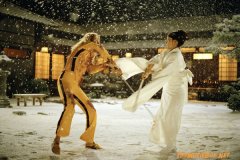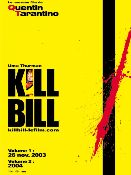Tarantino from the beginning to the end...
A lot of fans had to wait for this new production from Quentin Tarantino and I think, that they should had a lot of entertainment by watching it. On the one hand, the realisation is really a very good and creative job. The non chronological scenes, the animated sequences or the rooms shown from the top. And of course always the adapted songs.
On the other hand the violence is present in every sequence. For me it is to much. Blood, blood, blood! But it belongs also to the Tarantino's style...
Tarantino kills his idols.

I'm not sure why this film should be such a frenzy. Is it merely because it is a Tarantino film or is it because the film is considered to be the hypest genre movie endeavour of the 00s? We could almost be deceived into thinking that Tarantino actually owns genre movie. That he was the only one who could erect such a monument to cheap and campy entertainment. And there we end up contemplating an obvious contradiction: can we really give such a consideration to someone whose sole intention was to pay a tribute to the films he quite justifiably cherished?
Hold on a second! Are we sure we couldn't have expected anything better in that respect? The film boasts being "the 4th film by Quentin Tarantino" to start with, and we end up with a mere 3rd and a half! I thus understand it is too early to make any definite judgment about the film, but so far I tend to feel there's been more scavenging on T's part than any righteous "homage". We're even almost on the verge of profanation, if I may go so far, and all the more so as the graves are very fresh. Somehow the souls of the legendary figures of Asian cinema mentioned in the credits (May they be at rest) have no particular benefit to derive from that four-set production.
In a way, Tarantino seems to have applied the famous Yagyu adage "Kill your father if he stands in your way. Get rid
of Buddha if he interferes" uttered in the film from the very mouth of Kinnosuke Nakamura as a modus operandi for the shaping of a film whose indirect aim is to defile the sacred groud of Asian genre movie. The cue, taken from Fukasaku's Yagyu conspiracy, and later rephrased by the swordmaker played by Sonny Chiba, could therefore be seen as a way to justify such a crude treatment of references we know Tarantino takes very seriously.
Why did he have that film sound so fake? I figure someone who would consider those references as silly and who had treated them in a serious way would have been better off, and I think Jim Jarmush was more successful in that kind of approach with Ghost Dog.
But again I should wait until I've seen the second half (and it's such a pity the instruction scenes should only appear there) before giving a definite judgement.
Duel to the Death
Quentin Tarantino has always mentioned his passion for Asian movies, especially Shaw Brothers features and his "special movie sessions" given for his friends in his own home CINEMA in Hollywood are famous to show a lot of Asian movies. No surprise then, that he'd pay another tribute to one of his favorite genre - as he did for blaxploitation movies with "Jackie Brown" - by imaging "Kill Bill".
As mentioned in the end generic, the first idea of the plot has been imagined by "Q & U", meaning Quentin and Uma, while shooting "Pulp Fiction". Uma came up with the idea of a woman wanting to take revenge of some people for some reasons. Tarantino loved this simple plot, and promised to write some draft on about it. Months later, Uma asked to see what Quentin would have been written; and the later admitting having forgotten about the whole thing, but get back to it immediately. A few weeks later, at Uma's birthday, she got the very first draft of the movie, weighing already several hundreds of pages ! And Uma and Quentin to go on with the former movie.
Tarantino had already imagined from the start off to pay tribute to Asian movies and his producers from Miramax - a company which started of in the business thanks to the surprise hit "Reservoir Dogs" by Tarantino - gave him entire leisure to put in any silly idea he'd wish to. However, after seeing the result and especially the length of the movie (a little bit over 3 hours), they decide to release the movie in two distinct parts (as a reminder : Miramax, affiliated to Disney, are the very "professional" people, who love to buy big Asian box office hits, such as Jackie Chan movies and Stephen Chow's "Shaolin Soccer", cut whole parts of original editing and put some Americanized/Rap music over the whole, in order to "modernize" the movies...After that, they wonder why their rubbish releases don't meet any success).
Difficult to judge just a part of a movie - especially in this case, since yet to be released "Volume 2" is not just a sequel, but part of a whole. Personally, I'd like to await second part to review the whole, but I'd review just a few things which didn't work out and just won't be affected by second part :
Tarantino's principal quality is to have been able to create his very own style in just a very few movies, whereas other directors will spend a lifetime to achieve the same; moreover, all of his movies have been major "rip-offs" or at least recycled schemes of common genres, but put together in an undeniable own brand mark ("Reservoir Dogs" being inspired by "City on Fire" and thrillers out of the '50s; "Pulp Fiction" another tribute to the film noirs of the '50s and '60s; "Jackie Brown" recycling elements of blaxploitation...). "Kill Bill" uses the same pattern, even in a more accomplished way, since major scenes are composed by many elements of Asian movies - especially Shaw Bros features - or a whole scene being inspired by just another whole scene of a movie (final battle against Lucy Liu being a copy of "Lady Snowblood"; shadow battle being inspired by "Samurai Fiction" or Suzuki features); yet Tarantino "owns" those scenes in putting "his music" in it and breaking every kind of traditional narrative structure in multiplying flash-backs and -forwards , even extending in what he did in "Pulp Fiction".
Uses of music result in quite strange sceneries, where an air of corrida depicts the Bride's battle against Lucy Liu; and a rockabilly accompanies a ferocious battle; but it works out. As for the narrative structure, not being as complex and experimental as in Christopher Nolan's "Memento", Tarantino explores more profoundly what he did in "Pulp Fiction", but not hesitating to travel between past and future within a scene. This works out pretty fine, but his too many chapters deserve narrative structure and seem only there to point out and to make sure average spectator is not lost. He didn't need to, since he controls totally his subject - more self-confidence would have been better.
Tarantino's experimentation on picture is more present than ever; if he never went as far as a Steven Soderbergh in using colors, he certainly loves to play with the lightening. Using flashy elements as Pedro Almodovar did in his first features (clothes, the Pussy Wagon, house and interior in the suburb...), Tarantino loves to change between black and white and color. If he did it in a very discreet (and genius) way in "Pulp Fiction" (when Bruce Willis takes a ride in the cab after his boxing match, interior of cab is in colour, while exterior is in black & white !!), Tarantino really pushes experimentation far : uses b & w for the terrible flash back in church, but also for the huge brawl in the "Dragon Inn's" alike Japanese restaurant. Certainly in a matter to avoid censorship (in USA and several European countries, depiction of blood has to be "darkened" to avoid complete censorship, meaning that a scene can still be very violent, but may not show blood in its real color...), but also to revert to the violence of the attack in the church, picture becomes b & w / color in one eye glimpse.
Detail and use of the green-ish Sheriff's sunglasses, making appear "the Bride" as some king of zombi-ish or decomposed corpse while on, is just another great visual effect, which will certainly find many adepts in many films to come...
BUT the main flaw of the movie is it chosen tone. Starting off in a very savage, violent and destructive way, where the Bride knows no pity, where the world seems only to be composed by killers without any honor (first scene of killing), rapists (hospital), racist sheriffs (accusing mexicans of the murder without any evidence...), pedophile (yakuza in manga), the movie slows down and loses a lot of its impact during the Bride's stay in Okinawa. Complete change of tone (humour against violence), I wonder if there are no parts missing here, since the whole scene has not much impact, other than to introduce a nice cameo by Sonny Chiba as a - in wu xia pangs commonly used - sword forger. No training, no nothing, just a broken promise for the forger, former teacher of Luci Liu (?), Bill (?).
After Okinawa's stay, the whole movie starts definitely its tribute to Asian movies : while the only elements have been Shaw Bros - logo and the sword forger, the trip to Japan constitutes a nice game for any Asian-movies lover : with my limited knowledge, I only saw following elements : Bruce Lee's outfit (of course), manga (nice one !), Japanese bar just as most part of Shaw Bros "Dragon Inns"; shots from beneath the glass ground as in Suzuki's "Youth of the Beast"; Kato's "Green Hornet" mask, also reprised by Tsui Hark's "Black Mask"; one ennemy got his mouth slid, same as "Itchi the Killer"; shadow fight as in "Samurai Fiction" (which is also reprisal of great chambara classics), typical Japanese school girl reminding me as of heroes in "Fudoh"; school girls' weapon as in "Flying Guillotine"; finale as in "Lady Snowblood"; massive battle as in Tsui Hark's "The Master" (and much, much better here as the "Matrix Reloaded" laughable fight of Neo vs. Agent Smith on the play ground...).
Problem of the whole is, that Tarantino doesn't maintain the "Bride's" savageness; ambiance is not as cold and violent as before any more, but much more spectacular. For sure, Uma has to fight a "Duel to the Death" much more impressive as in the 1982's original movie with each new opponent, but her rage from the beginning seems to have gone. Let's see how she'll have to oppose her next opponents in "Volume 2".
Last, but not least, it is very interesting to see Tarantino's hommage to Asian movies, using Asian techniques (cables, blood bursts, ...), while Takeshi Kitano's "Zaitochi" clearly tries to match Western standards using even Westernized techniques (such as digital SFX for blood, etc)... Nice cross-over, which will hopefully be a new start of "mixing the genres" between East and West.
Kill Bill vol.1 
Violence,blood,awsome fight scenes(choreographed by Yuen Woo Ping) and original and smart story for revenge... All of these things make"Kill Bill vol.1" very entertaining.Thurman's performance is more than terrific!It's superbly directed and well-scripted. In a word it's billiant.It's 2003's best movie and one of the best ever made.Tarantino is a master!






